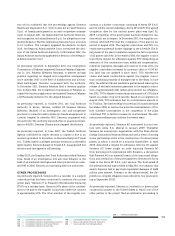Siemens 2012 Annual Report Download - page 295
Download and view the complete annual report
Please find page 295 of the 2012 Siemens annual report below. You can navigate through the pages in the report by either clicking on the pages listed below, or by using the keyword search tool below to find specific information within the annual report.
135 D. Consolidated Financial Statements 239 E. Additional Information
140 D. Consolidated Statements of Changes in Equity
142 D. Notes to Consolidated Financial Statements
232 D. Supervisory Board and Managing Board
136 D. Consolidated Statements of Income
137 D. Consolidated Statements of Comprehensive Income
138 D. Consolidated Statements of Financial Position
139 D. Consolidated Statements of Cash Flow
mainly to the sensitivity of the interest rates in connection
with the issuance of US$. billion and £. billion bonds in
fiscal . For additional information see -
.
Siemens’ production operations expose the Company to vari-
ous commodity price risks in the ordinary course of business.
Especially in the Sectors Industry and Energy a continuous
supply of copper was necessary for the operating activities.
Commodity price risk fluctuations may create unwanted and
unpredictable earnings and cash flow volatility. The Company
employs various strategies discussed below involving the use
of derivative financial instruments to mitigate or eliminate cer-
tain of those exposures.
Siemens has established a commodity price risk management
system to reduce earnings and cash flow volatility. Each
Siemens unit is responsible for recording, assessing, monitor-
ing, reporting and hedging its risks from forecast and pending
commodity purchase transactions (commodity price risk expo-
sure). The binding guideline for Siemens Divisions and entities
developed by the Corporate Supply Chain Management De-
partment provides the concept for the identification and deter-
mination of the commodity price risk exposure and commits
the units to hedge it within a narrow band of % to % of
the commodity price risk exposure in the product business for
the current and the subsequent quarter and % to % of
the commodity price risk exposure in the project business af-
ter receipt of order.
The aggregated commodity price risk exposure is hedged with
external counterparties through derivative financial hedging
instruments by Corporate Treasury. Derivative financial hedg-
ing instruments designated for hedge accounting are directly
entered into with external counterparties. Additionally,
Siemens applies a Company-wide portfolio approach which
generates a benefit from optimizing the Company ’s position of
the overall financial commodity price risk. For additional infor-
mation regarding the effect of this Company-wide portfolio ap-
proach on the Consolidated Financial Statements, as well as
for a discussion of hedging activities employed to mitigate or
reduce commodity price risks see -
.
Using historical volatilities and correlations, a ten day holding
period and a confidence level of .%, the VaR, which com-
prises the net position of commodity derivatives and the com-
modity purchase transactions with price risk, was € million
as of September , compared to € million as of Septem-
ber , .
Siemens’ investment portfolio consists of direct and indirect
investments in publicly traded companies held for purposes
other than trading. The direct participations result mainly from
strategic partnerships or compensation from M&A transac-
tions; indirect investments in fund shares are mainly transact-
ed for financial reasons.
The equity investments are monitored based on their current
market value, affected primarily by fluctuations in the volatile
technology-related markets worldwide. The market value of
Siemens’ portfolio in publicly traded companies as of Septem-
ber , was € million compared to € million as of
September , .
Based on historical volatilities and correlations, a ten day hold-
ing period and a confidence level of .%, the VaR as of Sep-
tember , of Siemens’ equity investments was € mil-
lion compared to € million the year before. Both changes,
the increase in market value and the increase in VaR, related
mainly to the increase of the market value of Siemens’ Atos
shares, received from Atos in connection with the divestment
of Siemens IT Solutions and Services.
Liquidity risk results from the Company ’s potential inability to
meet its financial liabilities, e.g. for the settlement of its finan-
cial debt or for ongoing cash requirements from operating ac-
tivities. In addition to having implemented effective working
capital and cash management, Siemens mitigates liquidity risk
by arranged credit facilities with highly rated financial institu-
tions, via a debt issuance program and via a global multi-cur-
rency commercial paper program. Liquidity risk may also be
mitigated by the Siemens Bank GmbH, which was established
in December . The Siemens Bank increased the flexibility
of depositing cash or refinancing by using European Central
Bank accounts. For further information regarding short- and
long-term debt see .
In addition to the above-mentioned sources of liquidity,
Siemens constantly monitors funding options available in the
capital markets, as well as trends in the availability and costs
of such funding, with a view to maintaining financial flexibility
and limiting repayment risks.
The following table reflects all contractually fixed pay-offs for
settlement, repayments and interest resulting from recognized
financial liabilities as well as from irrevocable loan commit-
ments. It includes expected net cash outflows from derivative
financial liabilities that are in place as per September , .
Such expected net cash outflows are determined based on
























